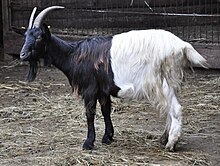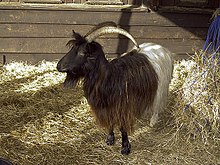Valais black-necked goat
The Valais black-necked goat , Vallesana goat (Ital.), Also known as saddle goat , glacier goat , Vispertal goat or juggler , is one of the oldest domestic goat breeds in the world. It is mainly held in the canton of Valais in Switzerland and the neighboring Piedmont and is considered a high mountain breed .
Appearance features
The Valais black-necked goat is mainly characterized by the fact that the front half of the body is black and the rear half is hairy white. The coat is basically long-haired. The head is relatively short and the ears protrude slightly. The female animals also have a forelock, as found in many other goat breeds only in males. Both sexes have horns ; the horns of the bucks can be up to 80 centimeters long.
Buck reach a height at the withers of 75 to 85 centimeters and then weigh 65 to 70 kilograms. Goats are slightly smaller and reach a height at the withers of 70 to 80 centimeters and weigh 45 to 50 kilograms.
Black-necked goats from the Valais are considered to be very productive fattening breeds. Their annual milk yield is 600 kilograms. It contains 3.1 percent fat and 3.0 percent protein . On average, 1.7 kids are born per goat each year. With this performance profile , they are one of the dual-purpose breeds typical of traditional agriculture.
distribution
The Valais black-necked goat is still a regional breed. It is mainly held in Upper Valais and there especially around the Vispertal , Zermatt and Saas-Fee . In Italy it is considered (one of the 12, according to Reg. Ce 1698/2005) endangered mountain goat breeds.
Breeding history
Although the Valais goat with its shaggy fur and impressive horns did not meet the breeding goal , it was very popular at the end of the 19th century. The glacier goat, as this goat is also called, is very robust and undemanding.
In the 1970s, the breed's continued existence was seriously endangered. The population in Switzerland was only 440 pure-bred animals. After a number of private individuals and associations committed themselves to the preservation of this breed, in 1999 the population was again at 274 male goats and 1297 herd book flocks. Their share of the total Swiss goat population was 11.6 percent.
Copper neck goat
Copper- necked goat is the name introduced by the ProSpecieRara Foundation in 2007 but has not yet been established in the specialist literature for a rare variant of the Valais black-necked goat.
See also
literature
- Josef Borter: The Valais black-necked goat . Dissertation at the University of Bern , 1975.
- Hermann Kunz: Blood groups and biochemical-polymorphic protein systems in the Appenzeller, Verzasca and Walliser black-necked goat . Dissertation at the University of Bern, 1974.
- Christian Zufferey (Ed.): Walliser Schwarzhalsziegen: Anniversary volume for the 25th anniversary of the Upper Walliser Goat Breeding Association . Rotten-Verlag, Visp 2004, ISBN 3-907624-96-3
Web links
proof
- The Walliser Schwarzhalsziege , in the goat lexicon , accessed on September 28, 2009
- Vallesana - Vallese , eng.agraria.org (English)





